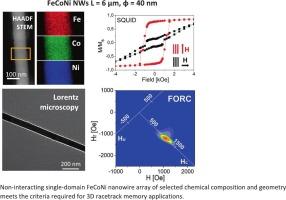不同几何形状FeCoNi纳米线磁性行为的演化
IF 4.6
3区 材料科学
Q2 MATERIALS SCIENCE, MULTIDISCIPLINARY
引用次数: 0
摘要
将不同直径(40 ~ 120nm)和长度(1.5 ~ 6µm)的FeCoNi纳米线(NWs)电沉积在聚碳酸酯膜上。磁测量证实了沿西北轴的各向异性。纳米线几何形状的变化导致了更小直径的矫顽力和正方形的增加。磁化反转机制的研究表明,矫顽力随角度的变化呈非单调变化,表明初始涡旋畴壁传播在接近硬方向的角度上转变为横向或相干旋转。FORC分析证实了纳米线直径是决定纳米线之间静磁相互作用的主要因素,并表明在小直径NW矩阵下,纳米线之间存在非相互作用体系。使用洛伦兹显微镜对样品进行的磁成像没有显示畴壁,这与FORC结果一起暗示了纳米线的单畴结构。因此,所获得的纳米线符合3D赛道存储器应用所需的标准。本文章由计算机程序翻译,如有差异,请以英文原文为准。

The evolution of magnetic behavior in FeCoNi nanowires with different geometry
FeCoNi nanowires (NWs) with different diameters (40–120 nm) and lengths (1.5–6 µm) were electrodeposited in the polycarbonate membranes. Magnetic measurements confirmed anisotropy along the NW axis. Changes in the nanowire geometry resulted in increased coercivity and squareness for smaller diameters. Studies of the magnetization reversal mechanism showed a non-monotonic coercivity variation as a function of angle, pointing out the initial vortex domain wall propagation that transformed into a transverse or coherent rotation at angles closer to the hard direction. FORC analysis confirmed that the nanowire diameter is the main factor determining magnetostatic interaction between nanowires and indicated a non-interacting system in the case of a small diameter NW matrix. Magnetic imaging of the sample using Lorentz microscopy did not reveal domain walls, which together with FORC results, implies a single-domain structure of nanowires. Therefore, the obtained nanowires meet the criteria required for 3D racetrack memory applications.
求助全文
通过发布文献求助,成功后即可免费获取论文全文。
去求助
来源期刊

Materials Science and Engineering: B
工程技术-材料科学:综合
CiteScore
5.60
自引率
2.80%
发文量
481
审稿时长
3.5 months
期刊介绍:
The journal provides an international medium for the publication of theoretical and experimental studies and reviews related to the electronic, electrochemical, ionic, magnetic, optical, and biosensing properties of solid state materials in bulk, thin film and particulate forms. Papers dealing with synthesis, processing, characterization, structure, physical properties and computational aspects of nano-crystalline, crystalline, amorphous and glassy forms of ceramics, semiconductors, layered insertion compounds, low-dimensional compounds and systems, fast-ion conductors, polymers and dielectrics are viewed as suitable for publication. Articles focused on nano-structured aspects of these advanced solid-state materials will also be considered suitable.
 求助内容:
求助内容: 应助结果提醒方式:
应助结果提醒方式:


